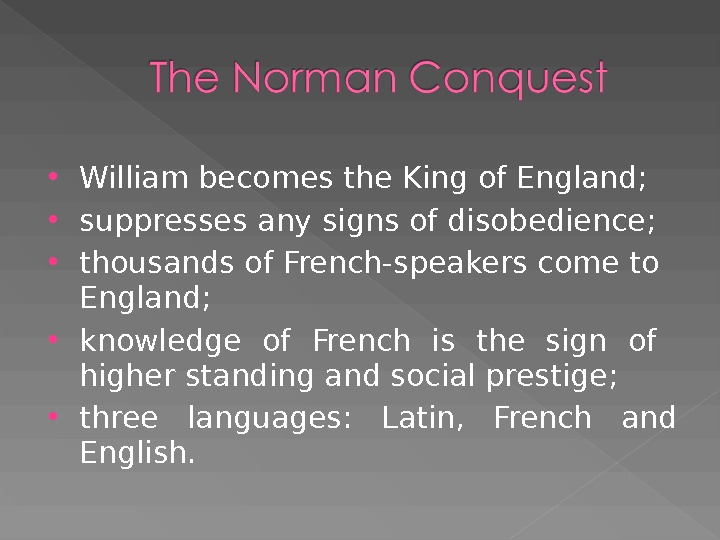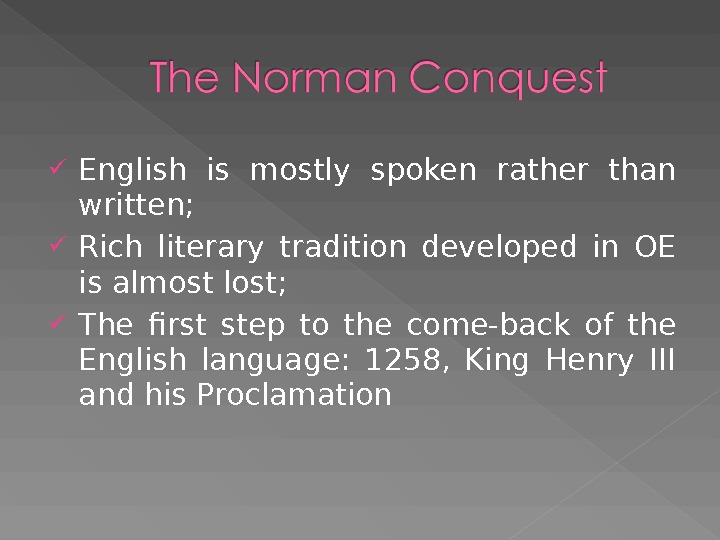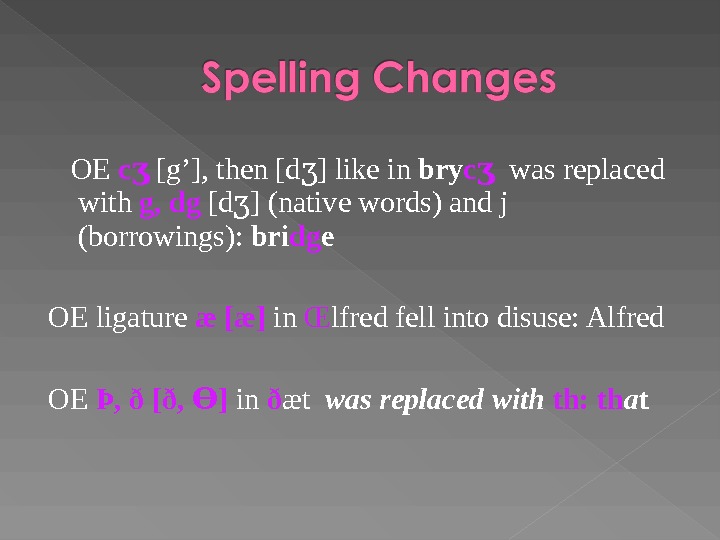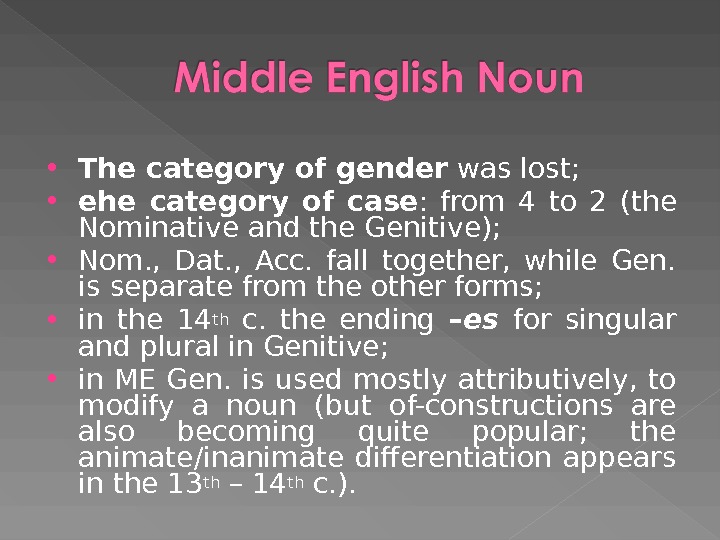Презентация middle enlgish









































- Размер: 1.5 Mегабайта
- Количество слайдов: 40
Описание презентации Презентация middle enlgish по слайдам

 Middle English (1066 – 1475)
Middle English (1066 – 1475)
 Scandinavian invasions English was significantly changed and simplified
Scandinavian invasions English was significantly changed and simplified
 the English kings were in exile; Edward the Confessor + William, Duke of Normandy; In 1042 English kings regain the rule in England; After Edward’s death Williams wants the throne, crosses the English Channel (October 14, the battle of Hastings).
the English kings were in exile; Edward the Confessor + William, Duke of Normandy; In 1042 English kings regain the rule in England; After Edward’s death Williams wants the throne, crosses the English Channel (October 14, the battle of Hastings).
 William becomes the King of England; suppresses any signs of disobedience; thousands of French-speakers come to England; knowledge of French is the sign of higher standing and social prestige; three languages: Latin, French and English.
William becomes the King of England; suppresses any signs of disobedience; thousands of French-speakers come to England; knowledge of French is the sign of higher standing and social prestige; three languages: Latin, French and English.
 English is mostly spoken rather than written; Rich literary tradition developed in OE is almost lost; The first step to the come-back of the English language: 1258, King Henry III and his Proclamation
English is mostly spoken rather than written; Rich literary tradition developed in OE is almost lost; The first step to the come-back of the English language: 1258, King Henry III and his Proclamation
 spelling (set up the basis for the present-day English spelling); a great number of borrowings; grammar was simplified and virtually unaffected by the Conquest.
spelling (set up the basis for the present-day English spelling); a great number of borrowings; grammar was simplified and virtually unaffected by the Conquest.
 English surnames appeared in ME: OE – Œt helred, son of Alfred the suffix -son: Johnson, Thompson; Later – place names, occupation and even nationality.
English surnames appeared in ME: OE – Œt helred, son of Alfred the suffix -son: Johnson, Thompson; Later – place names, occupation and even nationality.
 later entries made in Anglo-Saxon Chronicles, the Peterborough Chronicle; Ormulum, paraphrases of Gospels by the monk Orm; a romance (a story about the adventures of knights) Brut by Layamon (part of which is about Arthur and his knights); Chaucer’s Canterbury Tales, etc.
later entries made in Anglo-Saxon Chronicles, the Peterborough Chronicle; Ormulum, paraphrases of Gospels by the monk Orm; a romance (a story about the adventures of knights) Brut by Layamon (part of which is about Arthur and his knights); Chaucer’s Canterbury Tales, etc.
 F rench graphic habits were introduced; specifically English sounds (marked by Runic letters) were replaced by digraphs.
F rench graphic habits were introduced; specifically English sounds (marked by Runic letters) were replaced by digraphs.
![OE cʒ [g’], then [d ] like in ʒ bry cʒ was replaced OE cʒ [g’], then [d ] like in ʒ bry cʒ was replaced](/docs//middle_enlgish_images/middle_enlgish_10.jpg) OE cʒ [g’], then [d ] like in ʒ bry cʒ was replaced with g, dg [d ] (native words) and j ʒ (borrowings): bri dg e OE ligature æ [æ] in Œ lfred fell into disuse: Alfred OE Þ, ð [ð, ] Ɵ in ð æt was replaced with th: th a t
OE cʒ [g’], then [d ] like in ʒ bry cʒ was replaced with g, dg [d ] (native words) and j ʒ (borrowings): bri dg e OE ligature æ [æ] in Œ lfred fell into disuse: Alfred OE Þ, ð [ð, ] Ɵ in ð æt was replaced with th: th a t
![OE u [u: ] hūs, ūt, l ū fu, m ū nuc could be OE u [u: ] hūs, ūt, l ū fu, m ū nuc could be](/docs//middle_enlgish_images/middle_enlgish_11.jpg) OE u [u: ] hūs, ūt, l ū fu, m ū nuc could be replaced with ou, ow, o: ME h ou s [hu: s], h ow , c ow [hu: ]; [ku: ]; l o ve [luve]; m o nk [mu ŋ k]; OE hw hw æt was reflected as ME wh at [ hw at]
OE u [u: ] hūs, ūt, l ū fu, m ū nuc could be replaced with ou, ow, o: ME h ou s [hu: s], h ow , c ow [hu: ]; [ku: ]; l o ve [luve]; m o nk [mu ŋ k]; OE hw hw æt was reflected as ME wh at [ hw at]
![OE o [o: ] bōk was replaced with ME oo b oo k [bo: OE o [o: ] bōk was replaced with ME oo b oo k [bo:](/docs//middle_enlgish_images/middle_enlgish_12.jpg) OE o [o: ] bōk was replaced with ME oo b oo k [bo: k]; OE ē [e: ] fēld, fēt was reflected in ME as either ie, ee, or e [e: ]: field, feet
OE o [o: ] bōk was replaced with ME oo b oo k [bo: k]; OE ē [e: ] fēld, fēt was reflected in ME as either ie, ee, or e [e: ]: field, feet
![OE c, sc [k’, sk’ , then t ʃ, ʃ] scip, cild were OE c, sc [k’, sk’ , then t ʃ, ʃ] scip, cild were](/docs//middle_enlgish_images/middle_enlgish_13.jpg) OE c, sc [k’, sk’ , then t ʃ, ʃ] scip, cild were replaced with ch, sh (ssh, sch): ship, child; OE c [k] cnāwan was substituted with k before consonants: knowen; OE h [x, x’], [h] was reflected as h (he [he: ]) or gh (knight [knix’t]) ME.
OE c, sc [k’, sk’ , then t ʃ, ʃ] scip, cild were replaced with ch, sh (ssh, sch): ship, child; OE c [k] cnāwan was substituted with k before consonants: knowen; OE h [x, x’], [h] was reflected as h (he [he: ]) or gh (knight [knix’t]) ME.
![leveling of sounds (final and medial position) shwa, [ə] leveling of sounds (final and medial position) shwa, [ə]](/docs//middle_enlgish_images/middle_enlgish_14.jpg) leveling of sounds (final and medial position) shwa, [ə] marked as e OE cara cam care carum ME care (the paradigm is simplified)
leveling of sounds (final and medial position) shwa, [ə] marked as e OE cara cam care carum ME care (the paradigm is simplified)
 readjustment of quantity: vowel + two consonants – the vowel remains short or is shortened; exception – clusters mb, ld, nd OE wild [wild] > ME wild [wi: ld]; OE bewildran [i] > ME bewildren [be’wildren] OE fīfti [fi: fti] > ME fifty [fifti]. lengthening of short vowels in open syllables OE mete > ME mete [m Ɛ : te], OE nosu > ME nose [n Ɔ : ze].
readjustment of quantity: vowel + two consonants – the vowel remains short or is shortened; exception – clusters mb, ld, nd OE wild [wild] > ME wild [wi: ld]; OE bewildran [i] > ME bewildren [be’wildren] OE fīfti [fi: fti] > ME fifty [fifti]. lengthening of short vowels in open syllables OE mete > ME mete [m Ɛ : te], OE nosu > ME nose [n Ɔ : ze].
![monophthongization of diphthongs: (not new to the English language) long [e o: ] monophthongization of diphthongs: (not new to the English language) long [e o: ]](/docs//middle_enlgish_images/middle_enlgish_16.jpg) monophthongization of diphthongs: (not new to the English language) long [e o: ] > [ e: ] OE deop > deep [de: p] cases of returning to previous quality: Early OE arm > Late Old English earm (OE Breaking)> ME arm Goth þata > OE ðæt (splitting) > ME that
monophthongization of diphthongs: (not new to the English language) long [e o: ] > [ e: ] OE deop > deep [de: p] cases of returning to previous quality: Early OE arm > Late Old English earm (OE Breaking)> ME arm Goth þata > OE ðæt (splitting) > ME that
![changes in individual sounds: [a: ] – [ Ɔ : ] OE stān changes in individual sounds: [a: ] – [ Ɔ : ] OE stān](/docs//middle_enlgish_images/middle_enlgish_17.jpg) changes in individual sounds: [a: ] – [ Ɔ : ] OE stān [sta: n] – ME stone [st Ɔ : n ǝ ] OE hām – ME home
changes in individual sounds: [a: ] – [ Ɔ : ] OE stān [sta: n] – ME stone [st Ɔ : n ǝ ] OE hām – ME home
![[y], [y: ] gave [i, i: ] in the north and east; [y], [y: ] gave [i, i: ] in the north and east;](/docs//middle_enlgish_images/middle_enlgish_18.jpg) [y], [y: ] gave [i, i: ] in the north and east; [u, u: ] in the west; [e, e: ] in the south west. OE fyllan – ME fillen (to fill) OE dyde – ME dide (did) OE bryc ʒ – ME bridge OE bysi – Mod. E busy, business
[y], [y: ] gave [i, i: ] in the north and east; [u, u: ] in the west; [e, e: ] in the south west. OE fyllan – ME fillen (to fill) OE dyde – ME dide (did) OE bryc ʒ – ME bridge OE bysi – Mod. E busy, business
![OE [k‘] – ME [t ʃ ] marked by ch; OE [sk‘] – ME OE [k‘] – ME [t ʃ ] marked by ch; OE [sk‘] – ME](/docs//middle_enlgish_images/middle_enlgish_19.jpg) OE [k‘] – ME [t ʃ ] marked by ch; OE [sk‘] – ME [ ʃ ] marked by sh; h at the beginning of the word was lost in clusters hr, hl, hn, hw: OE hrin ʒ – ME ring, OE hrōf – ME roof
OE [k‘] – ME [t ʃ ] marked by ch; OE [sk‘] – ME [ ʃ ] marked by sh; h at the beginning of the word was lost in clusters hr, hl, hn, hw: OE hrin ʒ – ME ring, OE hrōf – ME roof
 n at the end of the verbs: preserved in the forms of the participle, and tended to be lost in the infinitive OE writan > ME written (Part 2) and ME write (infinitive) Lost in the numeral ān (one) that became in indefinite article ( a)
n at the end of the verbs: preserved in the forms of the participle, and tended to be lost in the infinitive OE writan > ME written (Part 2) and ME write (infinitive) Lost in the numeral ān (one) that became in indefinite article ( a)
 profound alteration: the grammatical type starts changing (synthetic to analytic); the changes in morphology are closely related to changes in the sound system (inflection were reduced, paradigms simplified).
profound alteration: the grammatical type starts changing (synthetic to analytic); the changes in morphology are closely related to changes in the sound system (inflection were reduced, paradigms simplified).
 The category of number preserved (semantically) and changed formally: -es used most often (even for borrowings: two felawes; the chambres and the stables; fresshe floures); -en (some n-stems retain their old uninflected plurals (oxen) ; former root stems retain their: man — menn, foot -feet, etc. ); nouns naming some domestic animals (such as sheep, swyn, hors) – uninflected plurals; the plural of child developed in a unique way (suffix of the former -s- stems (it was -r- through rhotacism) and additionally got the -en suffix – children, also brothren ).
The category of number preserved (semantically) and changed formally: -es used most often (even for borrowings: two felawes; the chambres and the stables; fresshe floures); -en (some n-stems retain their old uninflected plurals (oxen) ; former root stems retain their: man — menn, foot -feet, etc. ); nouns naming some domestic animals (such as sheep, swyn, hors) – uninflected plurals; the plural of child developed in a unique way (suffix of the former -s- stems (it was -r- through rhotacism) and additionally got the -en suffix – children, also brothren ).
 The category of gender was lost ; е he category of case : from 4 to 2 (the Nominative and the Genitive) ; Nom. , Dat. , Acc. fall together, while Gen. is separate from the other forms; in the 14 th c. the ending –es for singular and plural in Genitive; in ME Gen. is used mostly attributively, to modify a noun (but of-constructions are also becoming quite popular; the animate/inanimate differentiation appears in the 13 th – 14 th c. ).
The category of gender was lost ; е he category of case : from 4 to 2 (the Nominative and the Genitive) ; Nom. , Dat. , Acc. fall together, while Gen. is separate from the other forms; in the 14 th c. the ending –es for singular and plural in Genitive; in ME Gen. is used mostly attributively, to modify a noun (but of-constructions are also becoming quite popular; the animate/inanimate differentiation appears in the 13 th – 14 th c. ).
 simplification started in OE; towards the end of the ME – only some relics of the old system of declension (no strong vs. weak declension); degrees of comparison: the analytical way with “more, most” (French influence).
simplification started in OE; towards the end of the ME – only some relics of the old system of declension (no strong vs. weak declension); degrees of comparison: the analytical way with “more, most” (French influence).
 morphology of pronouns was simplified; some lexical replacements should be mentioned: OE hēo (3 rd p. , sin. , fem. ‘she’) was replaced by a group of variants he, ho, sce, sho, she , out of which the last finally prevailed; OE hīe (3 rd p. , pl. ‘they’) was replace by the Scand. loan-word they [Ɵei], its forms them and their (from Scand. too).
morphology of pronouns was simplified; some lexical replacements should be mentioned: OE hēo (3 rd p. , sin. , fem. ‘she’) was replaced by a group of variants he, ho, sce, sho, she , out of which the last finally prevailed; OE hīe (3 rd p. , pl. ‘they’) was replace by the Scand. loan-word they [Ɵei], its forms them and their (from Scand. too).
 New classes: possessive, reflexive, relative; personal pronouns: 4 to 2 case; the Gen. case of personal pronouns possessive pronouns; two variants of them in ME: myne/my; myne/my were used in free variation (n before a vowel); demonstrative pronouns (lost their case and gender distinction; preserved pl. /sg. forms: this – thes(e), thise / that – thos(e), tho.
New classes: possessive, reflexive, relative; personal pronouns: 4 to 2 case; the Gen. case of personal pronouns possessive pronouns; two variants of them in ME: myne/my; myne/my were used in free variation (n before a vowel); demonstrative pronouns (lost their case and gender distinction; preserved pl. /sg. forms: this – thes(e), thise / that – thos(e), tho.
 simplification of the morphological paradigm; increase in the number of verbal categories.
simplification of the morphological paradigm; increase in the number of verbal categories.
 gradual verbalization of non-finite forms; Strong verbs: 300 in OE 200 in ME: E. g. : to help, to climb, to walk turned from strong into weak verbs, which then turned into regular verbs. As to the preterite-present: modal meanings are preserved, paradigms are changed (defective verbs); suppletives (anomalous verbs) have always been the same: to be, to go.
gradual verbalization of non-finite forms; Strong verbs: 300 in OE 200 in ME: E. g. : to help, to climb, to walk turned from strong into weak verbs, which then turned into regular verbs. As to the preterite-present: modal meanings are preserved, paradigms are changed (defective verbs); suppletives (anomalous verbs) have always been the same: to be, to go.
 word groups, phrases, syntactical constructions, the first component of which gradually weakened or even lost its lexical meaning and turned into a grammatical marker (grammaticalization); most productive in verbs.
word groups, phrases, syntactical constructions, the first component of which gradually weakened or even lost its lexical meaning and turned into a grammatical marker (grammaticalization); most productive in verbs.
 The category of time correlation the verb to have in its main meaning + an object +an attribute, which referred to the object (to have something done). The Continuous forms: a compound nominal predicate with the verb to be as a link-verb and Participle I as a predicative. it didn’t express a process until later in the 16 th c.
The category of time correlation the verb to have in its main meaning + an object +an attribute, which referred to the object (to have something done). The Continuous forms: a compound nominal predicate with the verb to be as a link-verb and Participle I as a predicative. it didn’t express a process until later in the 16 th c.
 The passive voice: a compound nominal predicate with the verb to be + Participle II as a predicative. The future tense: a combination of a preterite-present verb (later modal) sculan or anomalous verb willan (later modal) with the infinitive.
The passive voice: a compound nominal predicate with the verb to be + Participle II as a predicative. The future tense: a combination of a preterite-present verb (later modal) sculan or anomalous verb willan (later modal) with the infinitive.
 In OE demonstrative pronouns sē, sēo, þæt were used as noun-determiners with a weakened meaning; by the 14 th c. – a separate word-form; Later – an indefinite article appeared (from the numeral and the indefinite pronoun ān)
In OE demonstrative pronouns sē, sēo, þæt were used as noun-determiners with a weakened meaning; by the 14 th c. – a separate word-form; Later – an indefinite article appeared (from the numeral and the indefinite pronoun ān)
 Word order – more strict; every place in a sentence came to be associated with a certain syntactic function; SVO (SPO) order; the use of the subject became obligatory; the use of prepositions more extensive; the growth of auxiliaries; further development of complex and compound sentences.
Word order – more strict; every place in a sentence came to be associated with a certain syntactic function; SVO (SPO) order; the use of the subject became obligatory; the use of prepositions more extensive; the growth of auxiliaries; further development of complex and compound sentences.
 Almost 80 % of OE words went out of use in succeeding periods: losses; replacements; additions (e. g. OE wer ʒeld ‘money paid to the family if one of the relatives was murdered; OE weorðan – ME become; ME duke); the great role of external sources in the extension of vocabulary.
Almost 80 % of OE words went out of use in succeeding periods: losses; replacements; additions (e. g. OE wer ʒeld ‘money paid to the family if one of the relatives was murdered; OE weorðan – ME become; ME duke); the great role of external sources in the extension of vocabulary.
 Scandinavian Influence : recorded in the 13 th c. ; especially numerous – place-names; more in the Northern dialects; Everyday life; early – military and legal matters; Bag, band, cake, egg, score, scrap, seat, skim, skirt, sky, ill, happy, loose, low, happen, scatter, rid, want.
Scandinavian Influence : recorded in the 13 th c. ; especially numerous – place-names; more in the Northern dialects; Everyday life; early – military and legal matters; Bag, band, cake, egg, score, scrap, seat, skim, skirt, sky, ill, happy, loose, low, happen, scatter, rid, want.
 The French Influence: a large number of French borrowings in ME; Several semantic spheres: governments and administration (council, power); military terms ( aid, army); law (accuse, cause, prove); church and religion (divine, honour, rule, sacrifice) and others; Not only words but also affixes could be borrowed.
The French Influence: a large number of French borrowings in ME; Several semantic spheres: governments and administration (council, power); military terms ( aid, army); law (accuse, cause, prove); church and religion (divine, honour, rule, sacrifice) and others; Not only words but also affixes could be borrowed.
 Borrowing from Classical Languages: not very numerous compared to French borrowings.
Borrowing from Classical Languages: not very numerous compared to French borrowings.
 great variety; difficult to decide on the number; in a rough way: four principal dialects (group of dialects): Northern, East Midland, West Midland, and Southern; the dialects differed in pronunciation, vocabulary, inflections; The London Dialect (predominantly South-Western, later – East Midland influence).
great variety; difficult to decide on the number; in a rough way: four principal dialects (group of dialects): Northern, East Midland, West Midland, and Southern; the dialects differed in pronunciation, vocabulary, inflections; The London Dialect (predominantly South-Western, later – East Midland influence).
 the ending of the pl. , pr. ind. of verbs: in OE — th with some variation of the preceding vowel. in ME: — eth in the Southern dialect, in the Midland district – en, in the north it was altered to – es, Loves; loven; loveth
the ending of the pl. , pr. ind. of verbs: in OE — th with some variation of the preceding vowel. in ME: — eth in the Southern dialect, in the Midland district – en, in the north it was altered to – es, Loves; loven; loveth

